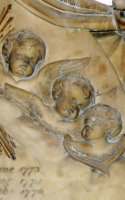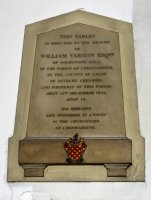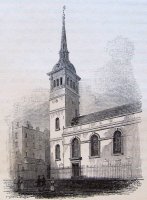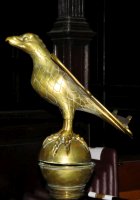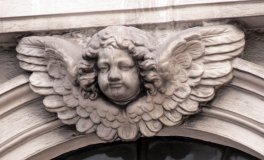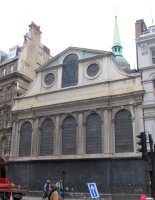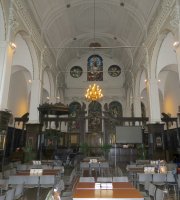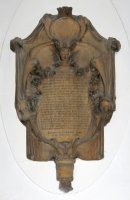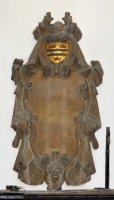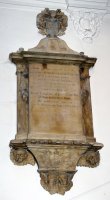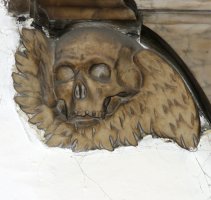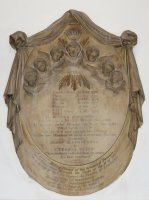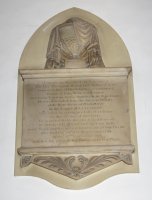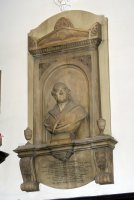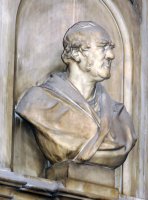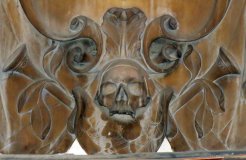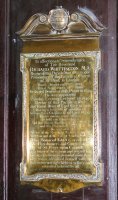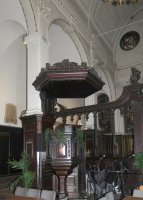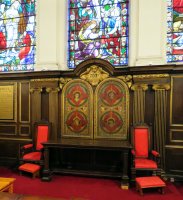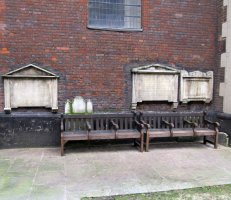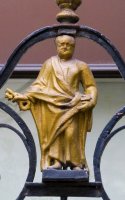St Peter Cornhill Church - Monuments
St Peter Cornhill is a surviving City of London Wren church which contains a modest collection of panel monuments, in addition to fine woodwork. Click any picture to enlarge, or hover for caption.
A few words on the Church building itself. There has been more than one building on the site, with firm written evidence for St Peter Cornhill by the early 12th Century - though see note towards the end of the page. The medieval church was immolated in the Fire of London and Christopher Wren put up the current Church from 1677-84, his masons being Joshua Marshall, who was also a prominent sculptor of his time, and Abraham Storey. The structure is largely surrounded by other buildings, but there is a little churchyard at the rear, away from Cornhill, from which we can see one wall, and the east end can be seen from Gracechurch Street, which includes some winged cherub heads which are likely Marshall’s (one of them is pictured above: click to enlarge). From Gracechurch Street we can also see the spire on a distinctive dome upon the square brick tower. All rather Italianate.
St Peter Cornhill.
Inside, we have five bays, aisles and a vaulted ceiling. The building is used as a back office for St Helen Bishopsgate, and a bit of a storage facility, so easier to admire the parts rather than the whole interior. The ceilings and upper walls remain impressive, with Corinthian capitals and some flowery mouldings. There are 17 stone panel monuments, mostly rather plain, but including two good cartouches, two panels with winged cherub heads (one with skulls too for good measure), and a mid-Victorian portrait bust. We take them in date order.
Monuments
The Venerable Jacob Buck, d.1685, with a lengthy Latin inscription. The earliest monument, styled as a cartouche, with scrolly and floral carving around it, drapes hanging from the top, knotted at the upper corners, and then hanging freely to the sides. A blank oval, presumably once a shield of arms, is above the inscription, with a winged cherub head; two further heads are at the lower sides, and there is a leafy terminus with bracket below. A good piece, dating from just a year after Wren’s church was completed.
Lewis Grenewell, d.1719 - really difficult to read - and William Grenewell, d.1722, erected by their sister Mary Grenewell, d.1737, continuing without a break to refer to 'the only Remains of Richard Grenewell', d.1722. The second cartouche, quite slender, with a violin-shaped central ground for the inscription, and the same general style as the earlier Buck monument, with the usual knots to the sides, cherub heads lower down, and scrolls and drapery. However, the painted shield of arms above is within a cartouche with helm and mantling, the knots to the sides are quite angular, and have small carved tassels hanging from them, and at the base is a skull with crossed wings, flanked by trumpets and leaves carved in low relief.
Jonathan & Isaac Gale, d.1741.
Jonathan Gale, d.1739, and Isaac Gale, d.1741, who lived in Jamaica. Rather a good piece, in darkened, streaky marble. To the sides are receding pilasters, carved with hanging drapes; above, a shelf supports a bell-shaped structure on which sits a large, painted shield of arms with much carved mantling. At the base, a gadrooned (corrugated) shelf, above an apron, with winged skulls to either side as corbels, and a the bottom, a pair of winged cherub heads.
Charles Chauncy, d.1763, and his wife Martha Chauncy, d.1752, and daughters Martha, Elizabeth and Mary. Plain oval with a rim.
Children of James and Mary Woodmason, d.1782 all together in a fire - the seven children aged from just 3 to 9 years old, are named, and at the top of the oval plaque are seven winged cherub heads carved in relief, a crown above, sunbeams behind (picture above, click to enlarge). The upper portion is carved with a fringed drape, knotted at the sides and hanging down. Said to be designed by Francesco Bartolozzi, a notable Italian engraver who in his nearly 4 decades in London, was elected Royal Academician, and carved, apparently, by a stonemason called Ryley, who is obscure.
The Revd. Richard Haighton, d.1810, ‘descended from the Ancient Family of the Haightons of Haighton, in the County of Lancaster, Rector of Long Stow and Croxton, Cambridgeshire.' Also his wife Mary [Pawson] Haighton, d.1795. With shelves, a draped pot carved in relief, and crossed branches and small brackets at the base. On a shaped white backing.
Revd. Haighton and Mary Haighton, 1810.
Harry Terry, d.1815, and Joseph Terry, d.1846. Cut as a simple tomb chest end, with shelf, pediment, and block feet, on a shaped white backing.
John Jones, d.1817, of Cardigan, Wales. Neat white tablet carved as a tomb chest end; on top is the curved ‘lid’ carved with shield of arms, wreath, and twisted ribbons, flowers in circles to the sides; the base is carved with little feet.
John Costeker, d.1817, his wife Jane Costeker, d.1818, and William Costeker Jr, d.1827, and Mary Costeker, d.1850, wife of William. Plain panel with moulded frame and small brackets.
The Nevis panels.
Nevis panels: Three adjacent rather similar panels to residents of the Island of Nevis, West Indies. Each consists of a panel with a surround, upper shelf, rounded pediment with a relief carving of a a broad urn, and below, moulded brackets. The central panel is to Miss Jane Smith, d.1820, erected by her sisters, and includes down-pointing torches emblematic of life snuffed out. Neighbouring panels of similar design but without torches are to Amelia Murphy, d.1820 and Christiana Smith, d.1841, and to Hester Smith, d.1844.
John Vardon, d.1809, and his wife Ellen [Wood] Vardon, d.1822, and children Ellen, d.1804, Henry, d.1820, and Charles, d.1826, and six infants, and Frances Wood, d.1808, sister of the elder Ellen. Panel with shelf, on a dark streaky backing cut with a low obelisk above, on which is a painted coat of arms. Signed by stonemasons Piper & Son – a long-running firm who were more builders than masons, with a few unambitious panel monuments, including one in St Magnus the Martyr. William Vardon’s monument is noted below.
Richard Knight, d.1828, plain plaque with border, and small supports.
Wix family, ca. 1840, commemorating Edward Wix, d.1787, his wife Mary Wix, d.1782, and four daughters and two sons: Mary Poynder, d.1835, Sarah Poynder, d.1802, Elizabeth Brown, d.1805, Martha Wix, d.1840, William Wix FRS of Tunbridge Wells, and The Revd. Samuel Wix, Vicar of St Bartholomew the Less. Tall panel with plain pediment above, blocky base, and slight carved scrolling to the sides.
William Vardon, d.1856. Tall panel with a point, and a thick shelf below with painted shield of arms, on brackets, with a white backing. Picture at top of page.
Richard Gibbs, likely by Henry Weekes.
Richard Gibbs, d.1864, with a bust. This shows him in late middle age, with a high domed forehead, sideburns, and heavy eyebrows. He wears a great cloak, giving a noble patrician look without resorting to Grecian dress, which was not the done thing by this time. The bust is seated within a round-headed arch, supporting a pediment with a winged circle in it, and acroteria to the top and sides. To left and right of the bust are small urns, and the base, where is the short inscription, is embellished with scrolly brackets carved with Acanthus leaves. There may be a signature under the dust, but if so I could not read it. Presumably by the Victorian sculptor Henry Weekes, who made a monument to a Richard Gibbs, d.1864, for St Matthew’s Brixton. He was an industrious and successful portrait sculptor, who was eminent enough that he was invited to make one of the groups for the Albert Memorial.
Cartouches: Buck and Grenewell.
Also in the Church:
The Church also contains several modern brasses, including ones listing people buried in the Church. A typical one is that to Joseph Cockfield Dimsdale, ‘First Baronet, privy Councillor, and Knight Commander of the Royal Victorian Order’, listing his various offices, including a term as Lord Mayor – we have red principal capitals, and a border with a simple repeating design. That to the Revd. Richard Whittington, d.1900, has a leaf and ribbon border and a curly pediment above, and is interesting in being designed by Ernest Flint, an architect of Edwardian Classical buildings.
Modern brass, font (hover for captions).
A metal panel in the Church, apparently copied from an earlier inscription made in the 1400s, states optimistically that the original church on the site was the first in London, founded in the year 179 by ‘Lucius, the first Christian King of this Land’, which was the ‘Chiefe Church of this Kingdom.. for 400 yeares and more’ until Canterbury took over. Hmm.
The woodwork is the pride of the Church. Most prominent is the full chancel screen, across both nave and aisles, is a less expected feature in a Wren church, and a requirement of the Rector at the time. The centrepiece of that is a cartouche coat of arms, with flanking rampant lion and unicorn on separate pillars, and a bulging-cheeked winged cherub head beneath.
Original woodwork: pulpit and reredos.
Other original woodwork includes door cases, and the very large pulpit, complete with sounding board or tester above, and lots of minor carving, the reredos with painted screen showing the Evangelists, ionic pilasters to the sides, and a variety of furniture, all dark and polished and giving a something of an ambience despite the modern functional desks and chairs filling most of the space.
The original font, 1681, is octagonal, with four winged cherub heads around the bowl, which is seated on leaves, and a slender single stem, also octagonal, with more ornate leaves below. The complex wooden cover is also original.
From a Victorian makeover in the early 1870s by the architect J.D. Wyatt, we have some floor tiles, and a brass eagle lectern, not of the usual type.
The stained glass includes some Victorian work, by Alexander Gibbs apparently, and some modern work by Hugh Easton on a military theme, for the Tank Regiment etc.
Churchyard
The tiny churchyard includes several panels on the outside wall of the Church, in the same style as interior monuments, tomb chest ends with lids or pediments, and acroteria (‘ears’) to the sides and little carved feet below. Early 19th Century, and a stray illegible headstone which would be late 18th Century.
The gate to the alley is Victorian ironwork, but the little figure of St Peter with his key, the architectural historian Pevsner suggests, may be 18th Century.
Just along the road, with a more significant collection of monuments, is St Michael Cornhill.
The Church website is at https://stpeteruponcornhill.org.uk/heritage.html.
